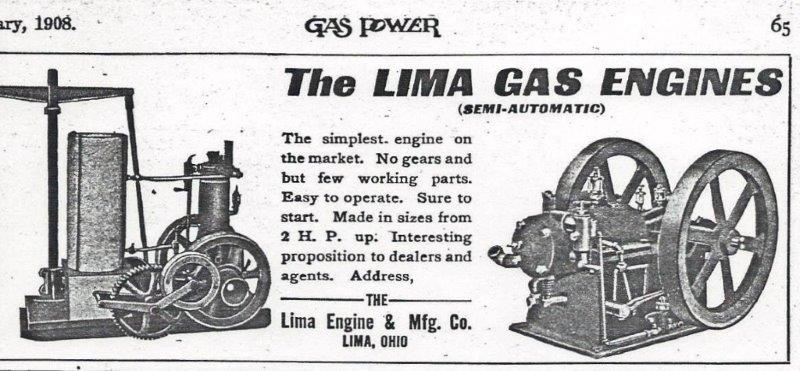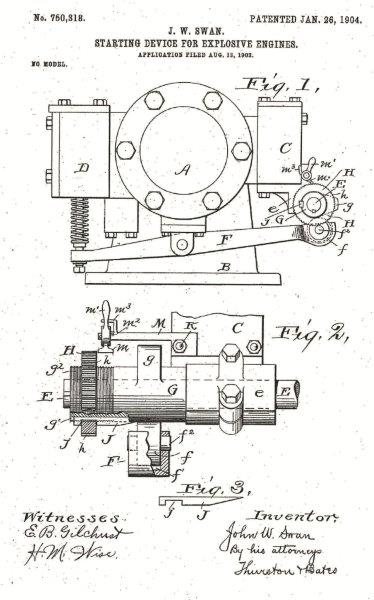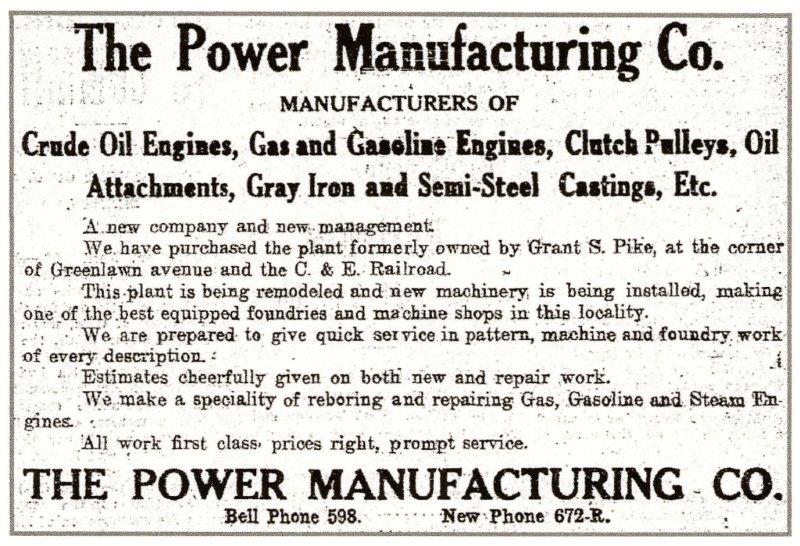|

November 2014
The Lima Story
By
Paul Harvey
Part 1: The History
Last month I chose to write about two of the more unusual engines at
the museum; the Swan and the Lima.
Soon I found that the information about the Swan and its designer, John
W. Swan, would consume the entire article, and it would be best to do it
in two parts. So this month I will tell a most unusual story of the
Lima and the many changes made in its short
history. It is a fascinating story of change that took place in a mere
five years. Next month will bring the third, and concluding, portion of
this tale. I hope you will enjoy reading the series as much as
I've enjoyed researching and writing it.
Today, Lima, Ohio,
is a city of 38,000 that is located in the northwestern part of the
state. Although the prosperity of the early 1900s has passed, it still
supports two major industries. First is the Ford Motor Company's engine
plant, recently expanded, that makes all the engines for their F-150
pickup trucks. Second is the Army Tank Plant that builds and maintains
all the M1 Abrams tanks and their successors.
The town of Lima,
Ohio, was established in 1831 and soon became the
county seat of Allen
County. It was named in honor of
Lima, Peru.
Located on the Ottawa River, it soon became the
crossroads to five major railroads which spurred its industrial growth.
Probably best known was the Lima Locomotive Works which soon rose to be
the third largest builder of locomotives in the nation.
Lima built all of the famous Shay gear drive
locomotives, as well as an extensive line of main line locomotives.
Its major contribution was William Woodward's design of the
"super-power" locomotive. This entailed a huge fire box, suspended over
a large rear truck assembly, to provide the heat needed to make steam
for very large and fast locomotives. These monsters found use pulling
gigantic coal trains easily over the mountains of
Virginia and West Virginia.
The largest class was a 2-6-6-6 wheel configuration and weighed 389
tons, pulling a tender full of water and coal and weighing 251 tons.
They produced 7,900 horsepower! They were the heaviest steam
locomotives ever built and one is on display at the
Ford Museum
in Dearborn, Michigan.
Oil was discovered near Lima
in 1885, and for the next decade, the Lima
field produced more crude oil than any other location in the world. The
demand for locomotive equipment, oil field equipment, and all sorts of
supply houses and machine shops certainly painted the picture of the
environment we find the Lima Gas Engine entrenched in. So, this is the
story of the short and hectic tale of that engine.
Picking up from where last month's, "The Swan Story" left off, we find
the Lima Daily News of
January 4, 1905, stating that the John Swan Company brought
suit to have its name changed to the Lima Gas Engine Company. There
were new directors and John Swan was eliminated from the company. His
tale was told in last month's article. The January 1905 issue of
Gas Engine Magazine informs us that Lima Gas Engine Company was
making engines from 2 1/2 hp to 100 hp in a four-cycle design with a
cross head. The 1906 edition of History of Allen County Ohio
mentions that Lima was still
building the Swan engine. It does not give design details; there is no
information to tell or explain the slight differences between the Swan
and the Lima and when the
change occurred. These differences will be discussed later in this
article.
The October 20, 1906 edition of the Lima Times-Democrat
states that the name of the Lima Gas Engine Company has been changed to
the Lima Engine & Manufacturing Company. Four new investors have been
added and now they would include making portable sawmills. These would
be sold from $300.00 to $1,000.00 each. Amos Herrold, formerly of the
sawmill department of the Aultman Taylor Company in
Mansfield, Ohio, would
supervise the new venture. The factory remains at its original location
on Greenlawn Avenue
and C&E Railroad corner.
On the lighter side, the Lima Daily News of
September 1, 1908, mentions that a big
Lima engine would be on display at the Labor Day
celebration. Entered in the parade, it won second prize in the float
class. After the event, it was shipped to a Wisconsin
buyer.
The March 23, 1908 edition of the Lima Daily News ran
an article stating that P. J. Sult, an oil capitalist from
Marietta, Ohio, bought the
Lima Engine and Manufacturing Company, and has completely renovated the
old plant. It would now employ 46 men but many more are expected to be
hired soon. He would build the Dempster oil-gas producer which
promises to "revolutionize the world's lighting and heating." This
device apparently made gas from the abundant local crude oil. The
article concludes by noting that, "Gas engines of every description are
manufactured and the product goes all over the world."
Photo 1 is an ad from an early 1908 Gas Power
magazine showing the new Lima Gas Engines. Noted to be built by the
Lima Engine and Manufacturing Company, they are a radical departure from
the Swan-Lima engine. It continues to say they are "semi-automatic"
with no gears and few working parts. This implies that the engine is
four-cycle and the exhaust valve is operated by cylinder pressure. This
is the principal of the McVicker gas engine. No further mention of
these engines can be found.
Mr. Sult's new venture of the gas producer was short-lived as noted in
the Lima Daily News of
October 22, 1909. A mere 13 months after the producer was
introduced, the company was in receivership! The Lima Trust Company
filed suit for an unpaid note of $1,973.90, and placed F. B. Closser in
charge of the concern. The Lima Engine and Manufacturing Company was
again for sale, and the producer portion was to be closed.
The April 23, 1911 issue of the Lima Daily News ran a
large article entitled, "NEW INDUSTRY WITH FUTURE." John M. Primm,
owner of the Primm Oil Engine Company of Vanburen,
Indiana, purchased the old Swan-Lima plant and
established the Power Manufacturing Company to continue building oil
engines of Primm's design. Again the plant was remodeled and the
machinery from Vanburen was moved to it. Mr. Primm would be vice
president and general manager. Already, they have a carload of oil
engines to be shipped to Texas.
They would also do pattern, machine, and foundry work, as well as
manufacture a line of oil field equipment. The article ends, "No one
heretofore connected with the old companies is now identified with the
new company; all litigation is ended, and the concern is in strong
hands." And, indeed, that was true and the new concern had a very
successful future and prospered. This story will be the subject of next
month's Flywheel Article.
Part Two: The Engine
The Lima and
the Swan engines have many similarities and many differences. The
museum is very fortunate to display a 25 hp model of each.
Photo 2 is a photo of the Lima
and Photo 3 is the Swan. They are included together
to make this comparison:
MAIN FRAME: Both engines have a long
main frame with a cross head, with a few minor differences in the main
bearing section. The Lima
has no provision for the patented exhaust box in the frame as does the
Swan. They both have side shafts.
HEAD: Both engines share the typical "Western
Ohio" "T" head design with the intake on the near side and the
exhaust on the off side. However, the Lima
valves are mounted horizontally and the Swan valves are vertical.
GOVERNOR: The Lima governor, mounted
near the crankshaft, is nicely machined and operates hit and miss,
while the Swan governor, mounted near the cylinder, is somewhat crude
and throttling.
IGNITION: The Lima
uses both ignitor and hot tube while the Swan is only hot tube.
FUEL: The Lima
has a combination mixer that can use either gas or gasoline while the
Swan is only gas. Our Lima
still has a vestige of its fuel pump.
FLYWHEELS: Both engines use identical wheels with
unique, riveted on, counter weights. The wheels bolt onto a hub that is
tightly keyed to the crankshaft. Presumably, the easy removal of the
wheels facilitated transporting the engine.
There is one more similarity between the two engines which is the unique
compression release to aid starting. It has a movable lobe on the
exhaust cam cluster, just opposite to the main exhaust cam. This is
screwed into place with the hand-wheel for starting, and then, as the
engine comes up to speed, it is withdrawn easily just by holding the
hand-wheel. It functions quite nicely. Photo 4 is John
Swan's 1904 U.S. patent
750,318 of his device. However, our Swan engine does
not employ it, but our Lima
does, as noted in Photo 5.
The museum's Lima resides in
the Founder's Engine House, where it was originally installed when
brought home. It was found on an oil lease, just across the
Allegheny River from Parker,
Pennsylvania, where it drove a unique push-pull
type of pumping power. Local information revealed that the original
lease owner had moved from Ohio
and brought the equipment with him. This was early Autumn, 1969.
Unfortunately, no photos of that location exist. Photo 6
shows the Lima on my
1946 Reo truck when it arrived in Coolspring. This was probably the
Reo's biggest load so far, and it sported a fresh paint job. As the
Founder's Engine House was only 12 feet by 20 feet at that time, the engine
was unloaded near its present location, as shown in Photo 7.
The next weekend, I made another trip back to the lease to retrieve
the original supporting timbers, on which it is now mounted.
Photo 8 is the Lima's
brass name plate. Note that it is serial number 547. The Swan does not
have a brass plate but has the information cast into the surface of the
head. Its serial number is 151. I wonder if the engines were numbered
consecutively or if Lima
started at one again? From the information gathered, I am dating our
Lima at 1905.
The cylinder detail of the Lima
is shown in Photo 9. Note the plunger of the gasoline
pump is hanging from the side shaft, with mounting holes for the pump on
the frame. The small gasoline mixer can be seen just to the left of the
gas pipe. The governor detent is shown on the right hand side of the
rock shaft operated by the exhaust cam. Evident on the exhaust cam
cluster is the patented compression release. The rock shaft extends
through the frame to move an arm that opens the exhaust valve. It
governs with the exhaust open. Also seen is the latch mechanism that
keeps the intake valve closed while idling. This is more complex and
better machined that the Swan's mechanism.
Photo 10 shows the beautifully machined governor head as
seen through the flywheel spokes. Noted is the side shaft spiral bevel
gear which also drives the governor. The "T" head design, typical of so
many engines built in Western Ohio, is very
evident in Photo 11. The exhaust chest is located on the
left where the starting air pipe enters. The intake chest is on the
right and shows the original hot tube chimney as well as the electric
ignitor. Note the well-finished rim of the head and the two jacking
screws to aid in its removal if needed. This design is both improved
and better finished than the similar parts on the Swan. It displays the
evolution of gas engine design!
The article concludes with Photo 12 taken from the April 29, 1911 issue of the
Lima Daily News. It announces a
new life for an old plant and the prosperous future to come. Power
Manufacturing Company and the Primm Oil Engine Company have an
interesting story to tell, and the tale will unfold in next month's issue
of The Flywheel.
Coolspring
Power Museum
is now closed for the winter but special tours can still be arranged by
advance notice. Please call 814-849-6883 or see our web site at
www.coolspringpowermuseum.org. Next year will be our special
30th Anniversary show featuring flame ignition engines. See you
then!
|












